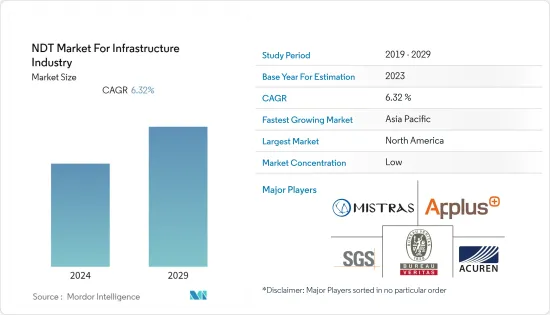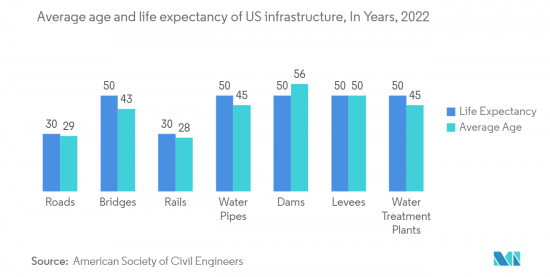 |
市场调查报告书
商品编码
1404084
基础设施产业无损检测产业-市场占有率分析、产业趋势与统计、2024年至2029年成长预测NDT For Infrastructure Industry - Market Share Analysis, Industry Trends & Statistics, Growth Forecasts 2024 - 2029 |
||||||
※ 本网页内容可能与最新版本有所差异。详细情况请与我们联繫。
基础设施产业无损检测市场上年度规模为405.3亿美元,预计未来5年将达588.3亿美元,复合年增长率为6.32%。
推动市场的关键因素之一是基础设施现代化投资的增加以及各领域新建筑和其他商业基础设施的建设。此外,基础设施现代化投资正在为所研究的市场创造商机。

主要亮点
- 无损检测是对零件、材料和组装的检查、测试和评估。在不影响产品可用性或组件的情况下研究属性的差异和不连续性。由于基础设施发展的进步、老化建筑物和桥樑数量的增加以及政府对公共日益关注,基础设施领域的无损检测市场正在迅速扩大。
- 自然灾害使房地产和基础设施资产面临最终考验,威胁其完整性并造成严重后果。技术性非侵入性和半侵入性测试越来越受欢迎,因为它可以帮助行业相关人员了解有关结构材质和预期用于新建筑的材料特性的重要资讯。我正在收集。这是因为基础建设领域投资较大,攸关人身安全。
- 此外,不断扩大的建设计划在基础设施领域的无损检测市场中发挥关键作用。这是因为现场和实验室测试是在材料和建筑构件的施工阶段进行的。该市场的开拓预计将得益于技术发展,使尖端变体变得容易获得。
- 合格无损检测专业人员的短缺预计在预测期内将持续存在。因此,无损检测市场需要更多训练有素的人力资源和培训设施,预计将影响预测期内的市场扩张。除此之外,大多数零件的检查深度通常限制在最大100-150mm,这意味着检查深度远小于光的波长。
- 此外,COVID-19大流行对无损检测(无损检测)行业产生了重大影响,因为进入基础设施场所受到限制,使得无损检测人员难以进行现场检查。 。这导致了检查过程的延误并降低了效率。行动限制增加了对远端无损检测技术的需求,例如用于基础设施检查的远端目视检查(RVI)和无人机(UAV)。儘管有效,但这些技术并不适合所有类型的基础设施,并且可能受到天气等因素的限制。
无损检测市场趋势
建筑业投资增加推动市场成长
- 无损检测在建设产业的应用十分广泛。无损检测被设计师、承包、建筑工程师和建筑商用来检验建筑结构和各种建筑材料的品质和完整性,并识别和量化潜在的缺陷。很有帮助。
- 近几十年来,建设产业投资大幅成长,尤其是在新兴国家。不断发展的都市化、工业化以及政府为经济弱势群体提供住宅的各种倡议是推动建设产业投资的关键因素。
- 影响市场的关键因素之一是众多政府对各类基础设施开发计划的持续投资。例如,土耳其政府计划在2021年投资3,250亿美元用于基础建设计划,包括对该国交通系统的投资以及对土木工程和道路施工机械的需求增加。
- 根据人口研究所 (PRB) 的预测,到 2022 年,世界上大约 57% 的人口将居住在都市区。按地区划分,北美地区的比例最高(83%),其次是拉丁美洲和加勒比海地区(81%)。这些趋势正在推动对新建筑和配套基础设施的需求,为所研究的市场创造成长机会。
- 此外,根据沙乌地阿拉伯的 2030 年愿景,公共和私营部门关注的建筑和基础设施发展的需求预计将继续增长。这项大规模倡议旨在扩大就业机会、实现经济多元化并为低收入群体提供住宅。

亚太地区占主要市场占有率份额
- 亚太地区工业领域的强大影响力和基础设施计划的快速发展预计将为无损检测服务提供重大成长机会。具体而言,中国、日本、韩国、印度、新加坡和澳洲预计将在未来几年为基础设施产业解决方案不间断的需求创造巨大潜力。
- 例如,根据澳洲基础设施合作伙伴组织2022年的研究报告,大约88%的投资者表示他们「可能投资澳洲的基础设施领域」。 84% 的投资者认为,澳洲在市场参与企业知识、基础设施和经济稳定性方面的记录是使澳洲成为有吸引力的投资目的地的最重要因素。
- 同样,印度对基础设施发展的日益重视正在吸引国内和国际参与企业。在该国,私营部门在电力、机场、通讯和道路等各种基础设施领域中发挥越来越重要的作用。
- 此外,到2022年,印度预计将超过中国,成为全球第三大建筑市场(根据IBEF)。 (根据 IBEF)。为确保该地区永续发展,印度拟透过国家基础设施管道(NIP)在2019年至2023年期间投资1.4兆美元用于基础建设计划。
- 此外,2021年2月,印度政府宣布未来五年将投资7.5兆印度卢比(1,024.9亿美元)用于石油和天然气基础设施,无损检测设备的需求预计将增加。到2023年,580亿美元将用于石油和天然气探勘和生产,其余金额将在2024年用于运输和发行天然气所需的基础设施,包括管道、进口码头和城市燃气发行网路。用于建筑。
无损检测产业概况
基础设施产业的无损检测市场本质上是分散的。在这个市场上,不同企业之间的竞争由价格、产品、市场占有率和竞争强度决定。透过创新可以获得永续的竞争优势。市场现有企业正在采取基于产品差异化、市场扩张和併购的强有力的竞争策略。市场上主要企业包括 SGS SA、Acuren Group Inc. 和 Mistras Group。
2023年6月,TCR Engineering宣布计划扩大在印度的材料测试和无损检测业务,目标是2025年首次股票公开发行(IPO)。该公司的无损检测服务包括超音波检测、X射线透视和磁粉检测。
2023年5月,SGS Gulf Limited宣布推出新的无损检测(无损检测)解决方案,能够对铁路轨道上运行的钢轨全长进行测试。这项新功能补充了 SGS 针对中东地区铁路基础设施的功能安全评估服务。
其他福利:
- Excel 格式的市场预测 (ME) 表
- 3 个月的分析师支持
目录
第一章简介
- 研究假设和市场定义
- 调查范围
第二章调查方法
第三章执行摘要
第四章市场洞察
- 市场概况
- 产业吸引力-波特五力分析
- 买家/消费者的议价能力
- 供应商的议价能力
- 新进入者的威胁
- 替代品的威胁
- 竞争公司之间敌对关係的强度
- 产业价值链分析
- 评估 COVID-19 对产业的影响
- 市场驱动因素与市场抑制因素简介
- 市场驱动因素
- 严格规定基础建设产业的安全标准
- 基础设施维护服务的成长
- 市场抑制因素
- 其他行业的无损检测服务抑制市场成长
第五章市场区隔
- 类型
- 设施
- 服务
- 科技
- X光检查
- 超音波探伤检验
- 磁粉检测
- 液体液体渗透探伤
- 目视测试
- 声波发射测试
- 热成像测试
- 雷射扫描测试
- 其他技术
- 最终用户产业
- 建设产业
- 工业领域
- 房地产行业
- 其他最终用户产业
- 地区
- 北美洲
- 欧洲
- 亚太地区
- 拉丁美洲
- 中东/非洲
第六章竞争形势
- 公司简介
- SGS SA
- Acuren Group Inc.
- Mistras Group Inc.
- Applus Services SA
- Bureau Veritas SA
- Teledyne FLIR LLC
- Infraspect(TFIC)
- Intertek Group PLC
- Olympus Corporation
- ROSEN Group
- Tech4Imaging LLC
第七章 投资分析
第八章 市场机会及未来趋势

The Non-Destructive Testing Market for the Infrastructure Industry was valued at USD 40.53 billion in the previous year and is expected to register a CAGR of 6.32%, reaching USD 58.83 billion by the next five years. One of the main factors propelling the market is an increase in investment in the modernization of infrastructures in various sectors and the building of new structures and other commercial infrastructures. Additionally, opportunities in the market under study are being created by investments in infrastructure modernization.
Key Highlights
- Non-destructive testing (NDT) is the inspection, testing, or evaluation of components, materials, or assemblies. It entails examining differences in characteristics or discontinuities without impairing the product's usability or a component. The market for non-destructive testing in the infrastructure sector is expanding quickly as a result of rising infrastructure development, an increase in the number of aging buildings and bridges, and growing government attention to public safety.
- Natural disasters put real estate and infrastructure assets to the ultimate test, threatening their integrity and posing severe consequences. Technical non-invasive and semi-invasive tests are gaining popularity because they help industry stakeholders learn crucial information about the properties of the materials the structures are made of or are anticipated to be used in new construction. This is because the infrastructure sector involves a significant investment, and human safety is on the line.
- In addition, expanding construction projects have a significant role in the infrastructure sector's non-destructive testing market. This is due to on-site or laboratory testing during the construction stage of materials and building components. The development of this market is anticipated to be aided by technological developments that make cutting-edge variants readily available.
- Over the forecast period, it is expected that the shortage of qualified NDT professionals will persist because there is yet to be an obvious solution. Therefore, the need for more trained personnel and training facilities in the NDT market is expected to impact the market's expansion over the forecast period. In addition to this, the depth of inspection for most components has been usually limited to a maximum depth of 100-150mm, which means that the inspection depth is much less than the wavelength of light.
- Furthermore, the COVID-19 pandemic had a significant impact on the non-destructive testing (NDT) industry owing to limited access to infrastructure sites, making it difficult for NDT inspectors to conduct on-site inspections. This led to delays and reduced efficiency in the inspection process. With travel restrictions in place, there was an increased demand for remote NDT inspection techniques such as remote visual inspection (RVI) and unmanned aerial vehicles (UAVs) for infrastructure inspection. While these techniques can be effective, they may not be suitable for all types of infrastructure and can be limited by factors such as weather conditions.
NDT Market Trends
Growing Investment in Construction Sector to Drive the Market's Growth
- The application of nondestructive testing in the construction industry is broad. NDT testing helps designers, contractors, construction engineers, and contractors verify the quality and integrity of built structures and various building materials and identify and quantify potential defects.
- Construction industry investments have grown significantly in the last few decades, especially across emerging countries. Increasing urbanization, industrialization, and various government initiatives to provide homes to economically weak people are among the primary factors driving investment in the construction industry.
- One of the key factors influencing the market is the ongoing investment by numerous governments in various infrastructure development projects. For instance, the Turkish government spent USD 325 billion on infrastructure projects in 2021, including investments in the country's transportation system and a rise in the need for earthmoving and road construction equipment.
- According to the Population Reference Bureau (PRB), in 2022, about 57 percent of people stayed in urban areas worldwide. In terms of region, North America has the highest (83) percentage of the population remaining in urban areas, followed by the Latin America and Caribean region (81 percent). Such trends drive the demand for new buildings and other supporting infrastructures, creating growth opportunities in the studied market.
- The need for construction and infrastructure development will also continue to rise in line with Saudi Arabia's Vision 2030 as the public and private sectors increase focus. Large-scale initiatives seek to expand employment opportunities, diversify the economy, and give lower-income groups housing options.

Asia-Pacific to Hold a Significant Market Share
- The Asia-Pacific region's strong presence in the industrial sector and rapid advancements in infrastructure projects are anticipated to provide significant growth opportunities for nondestructive testing services. Specifically, China, Japan, South Korea, India, Singapore, and Australia are expected to create huge potential for the nondestructive demand for infrastructure industry solutions in the coming years.
- For instance, according to a 2022 survey report by Infrastructure Partnerships Australia, about 88% of the investors indicated they are 'highly likely to invest in the Australian infrastructure sector. According to 84 percent of the investors, Australia's track record for knowledge of market participants, infrastructure, and economic stability are among the most important factors making Australia an attractive investment destination.
- Similarly, India's increased emphasis on infrastructure development is drawing domestic and foreign players. In the nation, the private sector is growing to be a significant player in various infrastructure sectors, from power and airports to communications and roads.
- In addition, by 2022, India was anticipated to overtake China as the third-largest construction market worldwide. (as per IBEF). To ensure sustainable development in the area, the nation intends to invest USD 1.4 trillion in infrastructure projects through the National Infrastructure Pipeline (NIP) between 2019 and 2023.
- Additionally, the Indian government announced in February 2021 that it would spend INR 7.5 trillion (USD 102.49 billion) on oil and gas infrastructure over the next five years, which is anticipated to increase demand for NDT equipment. By 2023, USD 58 billion would be spent on oil and gas exploration and production; the remaining sum might be used to build the infrastructure needed to transport and distribute natural gas, including pipelines, import terminals, and city gas distribution networks, by 2024.
NDT Industry Overview
The non-destructive testing market for the infrastructure industry is fragmented in nature. In the market studied the competitive rivalry between various firms depends on price, product, market share, and the intensity with which they compete. Sustainable competitive advantage can be gained through innovation. Market incumbents have adopted powerful competitive strategies based on product differentiation, market expansion, and mergers and acquisitions. Some of the key players in the market include SGS SA, Acuren Group Inc., and Mistras Group.
In June 2023, TCR Engineering announced its plans to expand its materials testing and non-destructive testing operations in India and is eyeing to launch its initial public offering (IPO) by 2025. The company's non-destructive testing services include ultrasonic testing, radiographic testing, and magnetic particle inspection, among others.
In May 2023, SGS Gulf Limited announced the introduction of a new Non-Destructive Testing (NDT) solution enabling the test of the whole running rail length of the railway tracks, with excellent throughput and coverage on a continuous basis. This new capability has complemented the SGS's range of functional safety assessment services for the railway infrastructure in the Middle East region.
Additional Benefits:
- The market estimate (ME) sheet in Excel format
- 3 months of analyst support
TABLE OF CONTENTS
1 INTRODUCTION
- 1.1 Study Assumptions and Market Definition
- 1.2 Scope of the Study
2 RESEARCH METHODOLOGY
3 EXECUTIVE SUMMARY
4 MARKET INSIGHTS
- 4.1 Market Overview
- 4.2 Industry Attractiveness - Porter's Five Forces Analysis
- 4.2.1 Bargaining Power of Buyers/Consumers
- 4.2.2 Bargaining Power of Suppliers
- 4.2.3 Threat of New Entrants
- 4.2.4 Threat of Substitute Products
- 4.2.5 Intensity of Competitive Rivalry
- 4.3 Industry Value Chain Analysis
- 4.4 Assessment of the COVID-19 Impact on the Industry
- 4.5 Introduction to Market Drivers and Restraints
- 4.6 Market Drivers
- 4.6.1 Stringent Regulations Mandating Safety Standard in the Infrastructure Industry
- 4.6.2 Growth in Infrastructure Maintenance Services
- 4.7 Market Restraints
- 4.7.1 NDT Services In Other Industries Restraining the Growth of the Market
5 MARKET SEGMENTATION
- 5.1 Type
- 5.1.1 Equipment
- 5.1.2 Services
- 5.2 Technology
- 5.2.1 Radiographic Testing
- 5.2.2 Ultrasonic Testing
- 5.2.3 Magnetic Particle Testing
- 5.2.4 Liquid Penetrant Testing
- 5.2.5 Visual Testing
- 5.2.6 Acoustic Emission Testing
- 5.2.7 Thermography Testing
- 5.2.8 Laser Scanning Testing
- 5.2.9 Other Technologies
- 5.3 End-user Industry
- 5.3.1 Construction Industry
- 5.3.2 Industrial Sector
- 5.3.3 Real Estate Industry
- 5.3.4 Other End-user Industries
- 5.4 Geography
- 5.4.1 North America
- 5.4.2 Europe
- 5.4.3 Asia-Pacific
- 5.4.4 Latin America
- 5.4.5 Middle-East and Africa
6 COMPETITIVE LANDSCAPE
- 6.1 Company Profiles
- 6.1.1 SGS SA
- 6.1.2 Acuren Group Inc.
- 6.1.3 Mistras Group Inc.
- 6.1.4 Applus Services SA
- 6.1.5 Bureau Veritas SA
- 6.1.6 Teledyne FLIR LLC
- 6.1.7 Infraspect (TFIC)
- 6.1.8 Intertek Group PLC
- 6.1.9 Olympus Corporation
- 6.1.10 ROSEN Group
- 6.1.11 Tech4Imaging LLC













